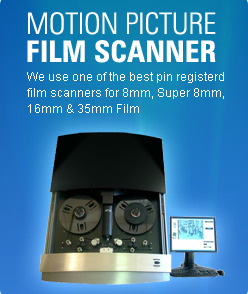
Film Conversion Equipment
Film Scanning and Film Transfer Equipment Types
The type of film scanning machine used for your 8mm, Super 8 or 16mm film conversion will have as much of an impact on the quality you receive as the resolution of the scan itself will. For example, if you wanted to digitize a photograph and tried doing it two different ways. You first put the photograph down on a table and took a picture of it using your smart phone or camera. Then you took the picture and scanned it using a flatbed scanner. If you compare the two side by side on your computer it will become really obvious that the flatbed scanner produced a digital image as good as the photograph. However, the picture you took with your phone or camera does not look close to the quality of the original photograph.
The same goes for scanning your 8mm, Super 8 or 16mm film. The real-time and frame by frame machines below are using a camcorder to take a picture of your film. The motion picture film scanner and Datacine machine are scanning the film. The results will be significantly different.
Film Conversion Equipment |
|
Real Time
|
|
Frame by Frame
|
|
Professional Film Scanners
|
|
Equally important as resolution is the type of film transfer. There are a few basic types of film transfer processes. More than 80% of the companies out there today use a real-time transfer. Any type of real-time film transfer will result in video that is 40-50% worse than the film’s current condition.
Billings Fun Facts: Just south of Billings the Battle of the Little Bighorn, also known as Custer’s Last Stand, took place on June 25, 1876. The Indians that day wiped out all of Custer’s men in less than 20 minutes. Arlo Guthrie attended Billings’ Rocky Mountain College in 1965. During the Wild West days in Billings, Montana, the cowboys and scarlet ladies of every saloon performed impossible dances atop bars, tables, and in some instances upon the pianos.
Montana Fun Facts: state by area, behind Alaska, Texas and California, but with an average of just six people per square mile, it is one of the country’s least densely populated states. Although the name Montana is derived from the Spanish montaña (“mountain” or “mountainous region”), it has an average elevation of only 3,400 feet, the lowest among the Rocky Mountain states. Montana is home to the Little Bighorn Battlefield National Monument, which memorializes the historic 1876 battle between the Sioux tribe and U.S. Army, often referred to as “Custer’s Last Stand.” Yellowstone National Park, located in southern Montana and northern Wyoming, was the first national park established in the United States.








